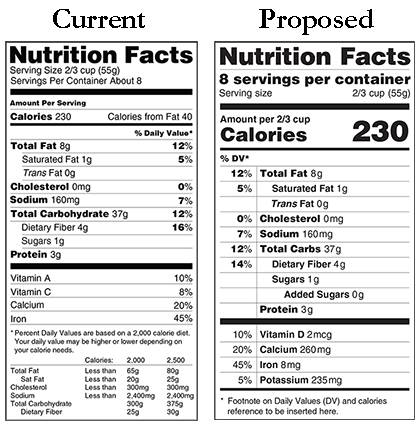Read Food Labels to Keep Healthy Practices
Nutrition labels on food packages to get first overhaul in 20 years

With National Nutrition Month winding down, it's time to look forward at what you can do to stick to healthy practices - and it may start with food labels.
Later this spring, the U.S. Food and Drug Administration hopes to approve new food labels for the first time in nearly 20 years to reflect the latest scientific information, including the link between diet and chronic diseases such as obesity and heart disease. The proposed label also would replace out-of-date serving sizes to better align with how much people really eat.
"Many people that I have worked with find labels to be confusing," said Esther Granville, nutrition program manager for LIVE FOR LIFE, Duke's employee wellness program. "They often are not aware of how to read and interpret the information so that it's useful, and the new label will aim to improve this,"
Among the biggest changes will be enlarging the size of numbers for calories per serving and clarifying the amount of sugar in food. Currently, labels show the total grams of sugar, but don't specify if sugar was added or if it's naturally occurring. The new label is designed to more clearly report extra added sugar, which will make it more useful for those who are trying to avoid more processed foods
Labels will also highlight the amount of potassium and Vitamin D in an item because the FDA has identified them as having "public health significance." Calcium and iron would continue to be required, and Vitamins A and C could be included on a voluntary basis.
Ultimately, the new label's goal is to present information in an easy-to-understand way.
That's convenient for Victoria Scott, a medical assistant in Duke Clinic. After having bariatric surgery in 2012, she focuses on a high protein, low carb diet because too many carbohydrates will irritate her stomach.
"I have to get 90 to 120 grams of protein in a day's time, so everything I pick up I flip it over and look at the label," said Scott, who can't have more than 50 grams of carbs a day. "I have to think about the calorie count, the carbohydrate count and then think, 'is this really worth eating?' "
For Scott, paying more attention to her diet, along with her surgery, has helped her lose nearly 180 pounds and resolve lingering issues with diabetes, high cholesterol and hypertension.
"You have to train yourself to pay attention to food labels, because if you're not used to it, you'll just pick up whatever appeals to your eye," Scott said. "I'd encourage everyone to do better with that."
Greenville agrees, noting that with the help of new labels, it should be easier for consumers to make healthier decisions moving forward.
"By reflecting what people are actually likely to consume, it should be less deceiving," Greenville said. "From a public health perspective, it will help focus more on disease and obesity prevention."